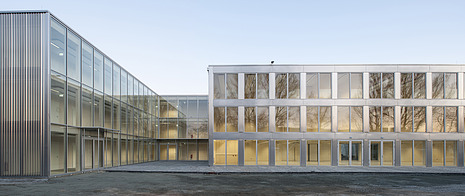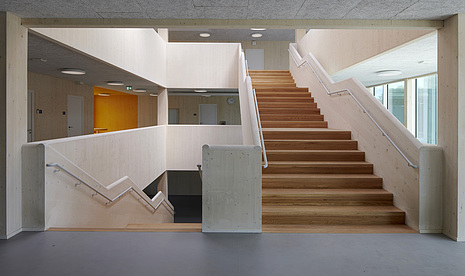Description
NKBAK architects turned to prefabricated modular timber construction when faced with the task of an urgently needed school building for 400 children within just 16 months. Planning for their previous European School Frankfurt am Main began in December 2013 and the finished building was completed by the end of the Easter holidays in 2015. Together with the modular timber construction specialists from Kaufmann Bausysteme in Vorarlberg, Austria, NKBAK developed a school made of timber room modules. 98 modules for classrooms (a standard classroom consists of three modules), toilets and washrooms and staircases were prefabricated by a timber construction firm in Styria, Austria and the modules then transported to Frankfurt’s Nordweststadt. In Frankfurt, the contractor then stacked the modules on top and next to each other to construct the shell of the school in only three and half weeks.
Only a few years later, the new school for ten nursery classes and seven primary school classes was strained to capacity. A shorter wing was added on the north side in 2018 and the school now has space for 16 primary school classes. The classrooms in the European School are square (9 × 9 metres). Having demonstrated that a school can be built quickly to a high-quality standard using the means of fabrication, it was no surprise that architects were soon asked to repeat the process elsewhere. In 2017, a temporary building for the Kalbach-Riedberg Integrated Comprehensive School was completed.
In March 2017, the architects were commissioned to design a first school in Berlin using the same principle, and by August 2019, it was ready for use, including a new sports hall. Unlike the projects in Frankfurt, the Integrated Secondary School in Mahlsdorf was intended as a permanent building from the outset and, with a total of 9360 m² gross floor area is considerably larger. It provides space for a level 1 secondary school with 4 parallel classes, a level 2 secondary school with 2 parallel classes, and also incorporates science rooms, a woodworking workshop, art and music rooms and a teaching kitchen.
The standardised classrooms are square and measure 73 m². The larger scale of the school means that alongside the distinctive coloured staircases, there is also a larger open stair that gives the school a distinct centre. As the exact schedule of required spaces was not decided when the project was commissioned, the school has the traditional arrangement of classrooms along a corridor. The brightly coloured lounge spaces at the end of each corridor can be used flexibly for group work or as communal areas. The alternating arrangement of the window divisions is not purely a design measure but a product of the need to incorporate horizontal opening casements to allow the rooms to be manually ventilated. Similar schools followed shortly after this project, i.e. the Primary School Konrad-Wolf-Strasse in Lichtenberg (2019) and the primary school in Sewanstrasse in Berlin-Friedrichsfelde (2020).
Originally published in Bauwelt 09.2020, pp. 40-47, abridged and edited for Building Types online, translated by Julian Reisenberger
 Exterior view
Exterior view
 Interior view
Interior view